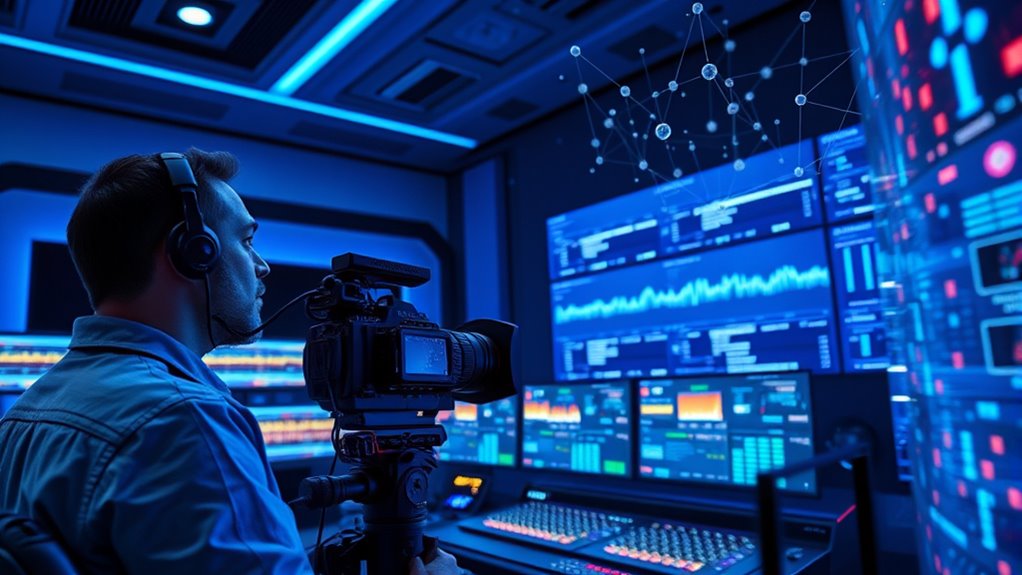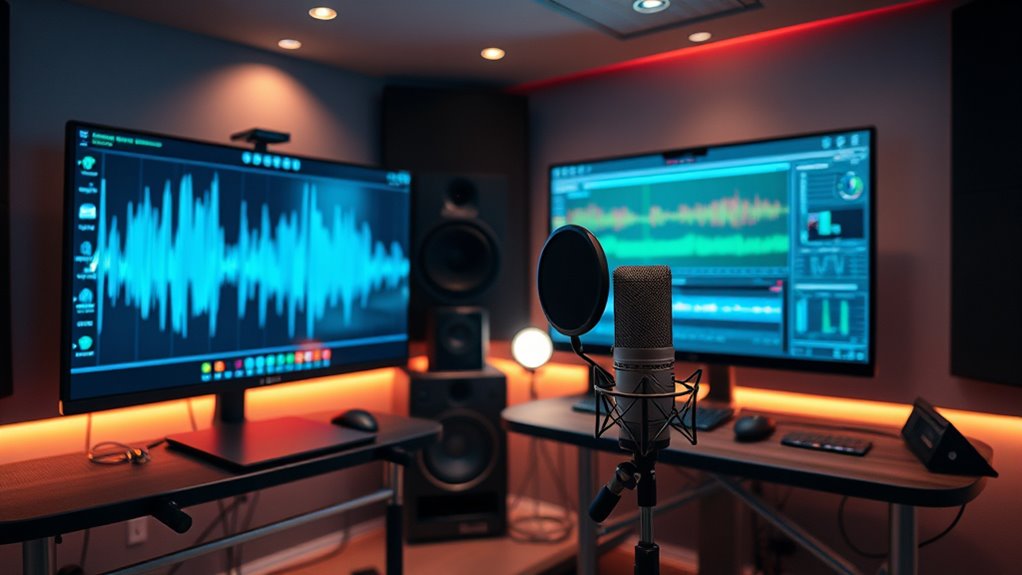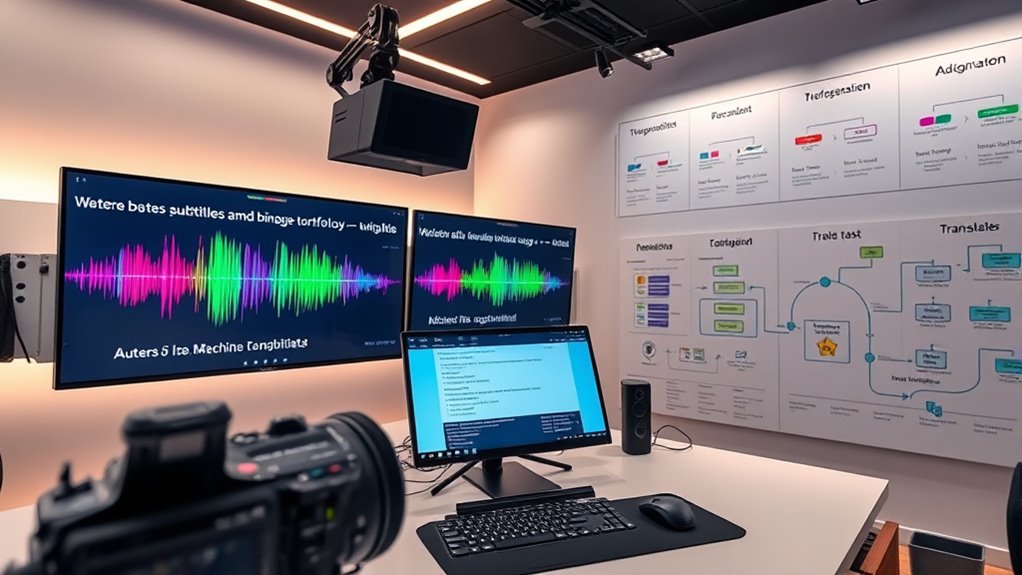Automated subtitle generation and translation workflows use AI, speech recognition, and machine learning to create accurate, synchronized, and multilingual captions efficiently. These systems convert speech to text, format and sync subtitles in real time, and employ neural machine translation to adapt content across languages. While challenges like data privacy and biases exist, ongoing advancements improve quality and speed. If you keep exploring, you’ll discover how these innovations are shaping the future of accessibility and media localization.
Key Takeaways
- Automated workflows integrate speech recognition, subtitle formatting, quality control, and accessibility features for seamless production.
- AI-driven synchronization ensures real-time, accurate subtitle timing aligned with video content.
- Neural machine translation models enable efficient multilingual subtitle generation with cultural and contextual accuracy.
- Quality enhancement uses neural networks to reduce errors, handle dialects, and improve emotional and tonal accuracy.
- Best practices include user feedback, transparency, data privacy, and regular testing to optimize automation efficiency and reliability.
The Evolution of Subtitle Technologies

The evolution of subtitle technologies reflects how advancements have continuously improved the accuracy and efficiency of video accessibility. Historical developments, such as the shift from manual transcription to automated speech recognition, marked significant milestones. Early industry adoption was slow, but as technology improved, more broadcasters and streaming platforms embraced automated solutions. These developments reduced human error, sped up production times, and made subtitles more consistent. Over time, industry adoption grew as tools became more sophisticated, integrating machine learning and AI to enhance accuracy. Today, the rapid pace of innovation continues to shape subtitle creation, making it more accessible, reliable, and scalable across various media formats. This ongoing evolution underscores the importance of technological progress in democratizing content for all viewers. Additionally, the integration of high-quality projector technology has contributed to better viewing experiences in home cinema setups, paralleling the advancements in subtitle creation. The increasing use of speech recognition AI has further accelerated the subtitle generation process, enabling real-time captioning in many live broadcasts. As the accuracy of automated captions improves, viewers benefit from more precise and meaningful subtitles, fostering greater inclusion for audiences with hearing impairments. Furthermore, ongoing research in software quality assurance and standardized testing protocols ensures these technologies meet high standards of reliability and performance, supporting widespread adoption.
Core Components of Automated Subtitle Workflows

Building on the advancements in subtitle technology, understanding the core components of automated subtitle workflows reveals how these systems operate seamlessly. You start with transcription, where speech recognition converts audio into text, forming the foundation. Next, subtitle formatting organizes this text into timed segments, ensuring proper display on screen. You also need quality control tools to review and refine the output, maintaining accuracy and consistency. User accessibility is a priority, so features like adjustable font size and color contrast are integrated. These components work together to produce synchronized, well-formatted subtitles that enhance viewer experience. By streamlining this process, you guarantee subtitles are not only accurate but also accessible, making content more inclusive and engaging for diverse audiences.
Speech Recognition and Transcription Accuracy

While speech recognition technology has advanced markedly, achieving high transcription accuracy remains a critical challenge. Variations in accents, background noise, and speech clarity can impact how well the system captures spoken words. To improve transcription accuracy, you should focus on key factors such as:
Achieving high transcription accuracy requires high-quality audio and advanced recognition models.
- Choosing high-quality audio sources for clearer speech input.
- Using advanced speech recognition models trained on diverse datasets.
- Implementing post-processing corrections to address errors in automatic transcriptions.
- Understanding regional dialects and local language nuances can further enhance recognition precision. Additionally, incorporating diverse datasets during model training helps systems better recognize a wide range of speech patterns and accents. Considering noise reduction techniques can also significantly improve clarity and accuracy in challenging environments. Employing real-time feedback from users can further help in refining the accuracy of speech recognition systems over time. Recognizing speaker variability is essential for adapting the system to different voices and speaking styles.
Machine Translation Techniques for Multilingual Content

Effective machine translation techniques are essential for accurately converting multilingual content, especially in a globalized digital landscape. You need methods that go beyond direct word substitution, focusing on contextual adaptation to preserve meaning across languages. Neural machine translation (NMT) models excel here, capturing nuances and idiomatic expressions. Cultural localization is equally important; it ensures translations resonate with target audiences by adapting references, humor, and cultural nuances appropriately. Incorporating feedback loops and domain-specific training improves accuracy and relevance. These techniques allow you to produce natural, culturally appropriate subtitles that enhance viewer engagement. By prioritizing contextual adaptation and cultural localization, you guarantee your multilingual content maintains its original intent and emotional impact across diverse audiences. Additionally, understanding the trustworthiness of AI models can help ensure the reliability of automated translation outputs in sensitive or critical applications.
Integrating AI for Seamless Subtitle Synchronization

Integrating AI helps guarantee subtitles stay perfectly synchronized with video in real time, which improves viewer experience. You can leverage advanced techniques to minimize lag and automate adjustments instantly. With AI-driven accuracy, you get more reliable and seamless subtitle synchronization across diverse content. Additionally, understanding content clusters can inform content creators about engaging educational material related to wellness topics. Recognizing vehicle tuning options can also inspire content that appeals to automotive enthusiasts seeking customizations.
Real-Time Synchronization Techniques
Achieving seamless subtitle synchronization in real-time requires sophisticated AI-driven techniques that can adapt instantaneously to audio-visual cues. These methods focus on precise timestamp alignment and latency reduction to keep subtitles perfectly in sync with speech and action. To optimize your workflow, consider these key strategies:
- Implement dynamic timestamp adjustment algorithms to refine subtitle timing on the fly.
- Use predictive models that anticipate speech patterns, minimizing latency.
- Integrate multi-source audio and video data to enhance synchronization accuracy.
- Incorporate natural elements into your setup, such as calming decor, to create a more relaxed and focused environment for editing. Additionally, understanding the importance of audio-visual synchronization can improve the overall quality and viewer experience of your subtitled content. Furthermore, understanding the importance of organic and natural juices can inspire a calm and healthy workspace atmosphere, promoting better focus and clarity during editing sessions. Incorporating retail hours awareness can also help in scheduling your editing sessions around store timings for supplies and equipment. Paying attention to real-time processing techniques can further enhance the effectiveness of your synchronization workflows.
AI-Driven Accuracy Improvements
Leveraging AI to enhance subtitle synchronization substantially boosts accuracy by enabling the system to adapt dynamically to audio-visual cues. By analyzing voice modulation and speech patterns, AI can precisely align subtitles with spoken words, even amidst varying tones or accents. This reduces timing errors and creates a smoother viewing experience. Accurate synchronization keeps viewers engaged, as subtitles appear exactly when needed, preventing distractions. Incorporating AI-driven techniques helps the system learn from real-time feedback, improving over time. This continuous refinement ensures subtitles match the pace and emotion of the content, enhancing clarity and immersion. Additionally, understanding content types helps optimize synchronization methods for different genres and media formats. Furthermore, integrating essential oils for audio clarity can enhance auditory perception for viewers with hearing difficulties. Ultimately, AI-driven accuracy improvements elevate viewer engagement by providing seamless, natural synchronization that aligns perfectly with the audio and visual cues of the media.
Challenges and Limitations in Automation Processes

Despite the advancements in automated subtitle generation and translation, several challenges hinder their seamless implementation. Data privacy concerns arise when handling sensitive content, requiring strict compliance with regulations. Algorithm bias is another obstacle, as biased models can produce inaccurate or culturally insensitive subtitles, damaging user trust. Additionally, technical limitations impact accuracy and timing, especially with complex language or accents.
Automated subtitles face challenges like data privacy, algorithm bias, and technical accuracy issues.
- Ensuring data privacy without compromising performance
- Overcoming algorithm bias for fairer translations
- Improving accuracy amid linguistic complexities
These issues highlight the need for ongoing refinement. You must address data privacy to protect user information, combat algorithm bias to ensure fairness, and enhance technical robustness for better results. Recognizing these limitations enables you to develop more reliable and ethical automation workflows.
Best Practices for Implementing Subtitle Automation

Implementing subtitle automation effectively requires careful planning and adherence to best practices that guarantee both accuracy and ethical standards. Focus on designing a user interface that simplifies workflows and enhances user engagement. An intuitive interface minimizes errors and speeds up review processes, ensuring subtitles meet quality standards. Regularly test your automation tools with real content to identify issues early and refine algorithms. Prioritize transparency by clearly communicating automation limits to users, building trust. Incorporate feedback from users to improve functionality and usability continuously. Maintain data privacy and ethical considerations, especially when handling sensitive content. By integrating these practices, you [GUARANTEE] your automated workflow is reliable, efficient, and user-friendly, ultimately delivering better viewing experiences while maintaining high standards.
Future Trends in Subtitle Generation and Translation

AI will continue to improve subtitle quality by reducing errors and enhancing accuracy. Multilingual neural models are likely to make real-time translation more seamless across diverse languages. These advancements will shape how you create and consume subtitles in the future.
AI-Driven Quality Enhancement
As technology advances, AI-driven tools are set to dramatically improve the quality of subtitles and translations. Neural networks will become more sophisticated, enabling more accurate transcriptions and context-aware translations. Sentiment analysis will help guarantee subtitles reflect the correct tone and emotional nuance, enhancing viewer engagement. To achieve this, you can expect:
- Enhanced accuracy through deep learning models that adapt to various languages and dialects.
- Better contextual understanding, reducing errors caused by homonyms or idiomatic expressions.
- Improved emotional alignment, ensuring subtitles capture subtleties like sarcasm or sentiment shifts.
These innovations will make subtitles more natural, culturally sensitive, and aligned with the original content, elevating the overall viewing experience for audiences worldwide.
Multilingual Neural Models
Multilingual neural models are poised to revolutionize subtitle generation and translation by enabling seamless communication across diverse languages. These models leverage advanced architectures to handle multiple languages within a single framework, reducing the need for separate systems. With language-specific tuning, you can improve accuracy and cultural relevance, ensuring subtitles resonate with local audiences. Multilingual neural models allow you to streamline workflows by translating and generating subtitles simultaneously, cutting down turnaround times. As these models evolve, expect to see more sophisticated handling of idiomatic expressions and context. This technology will make your subtitle workflows more efficient, flexible, and scalable, breaking down language barriers and broadening global reach. Embracing these innovations will position you at the forefront of future subtitle translation trends.
Frequently Asked Questions
How Do Automated Workflows Handle Regional Language Dialects?
Regional dialects and linguistic diversity add complexity to language processing. Automated workflows handle this by using advanced algorithms and machine learning models trained on diverse datasets. They recognize regional variations and adapt translations accordingly. You’ll find that these systems continuously improve as they learn from new dialects, helping guarantee subtitles accurately reflect local language nuances. This way, viewers experience more authentic and culturally relevant content, bridging gaps created by linguistic diversity.
What Are the Cost Implications of Large-Scale Subtitle Automation?
Oh, the joy of endless subtitles on a budget! When you scale up, cost efficiency becomes your best friend, but beware the scalability challenges—they can drain your funds faster than you can say “multilingual.” Large-scale automation saves money initially, but hidden costs like maintenance and quality control lurk. So, while it promises affordability, you might find yourself pouring more resources into perfecting those subtitles than you expected.
How Do Automation Tools Ensure Cultural Sensitivity in Translations?
When addressing cultural sensitivity, automation tools focus on recognizing cultural nuance to avoid misunderstandings. You should guarantee these tools incorporate sensitivity training for their algorithms, which helps them better interpret context and idiomatic expressions. By continuously refining these models with culturally relevant data, you can improve translation accuracy, ensuring your subtitles respect and accurately represent diverse audiences. This proactive approach minimizes misinterpretations and promotes respectful, inclusive communication.
Can Automated Systems Adapt to Different Video Formats and Qualities?
Think of your automated system as a chameleon, blending seamlessly with each environment. It adapts to different video format compatibility, adjusting to the size, aspect ratio, and encoding. It also performs quality adaptation, ensuring subtitles sync perfectly even when video resolution fluctuates. By using advanced algorithms, it reads the visual landscape and modifies its approach, so your subtitles remain clear and synchronized across every format and quality level you encounter.
What Are the Privacy Concerns in Automated Subtitle Processing?
When considering privacy concerns in automated subtitle processing, you worry about data security and maintaining user anonymity. You might transmit sensitive video content over networks, risking data breaches or unauthorized access. To protect yourself, verify the system uses encryption, secure servers, and anonymizes user data. Being aware of these risks helps you safeguard your content and personal info, keeping your video projects private and secure throughout the subtitle generation process.
Conclusion
By embracing innovative ideas and integrating intelligent algorithms, you can effortlessly enhance your subtitle workflows. Overcoming obstacles with optimism, you’ll optimize accuracy and accessibility, turning tedious tasks into seamless solutions. Stay savvy with the swiftly evolving scene, and let technology transform your translation and timing. With wisdom and wit, you’ll weave words with wonder, welcoming a world of wider audiences and richer experiences—creating engaging captions that connect, communicate, and conquer.









